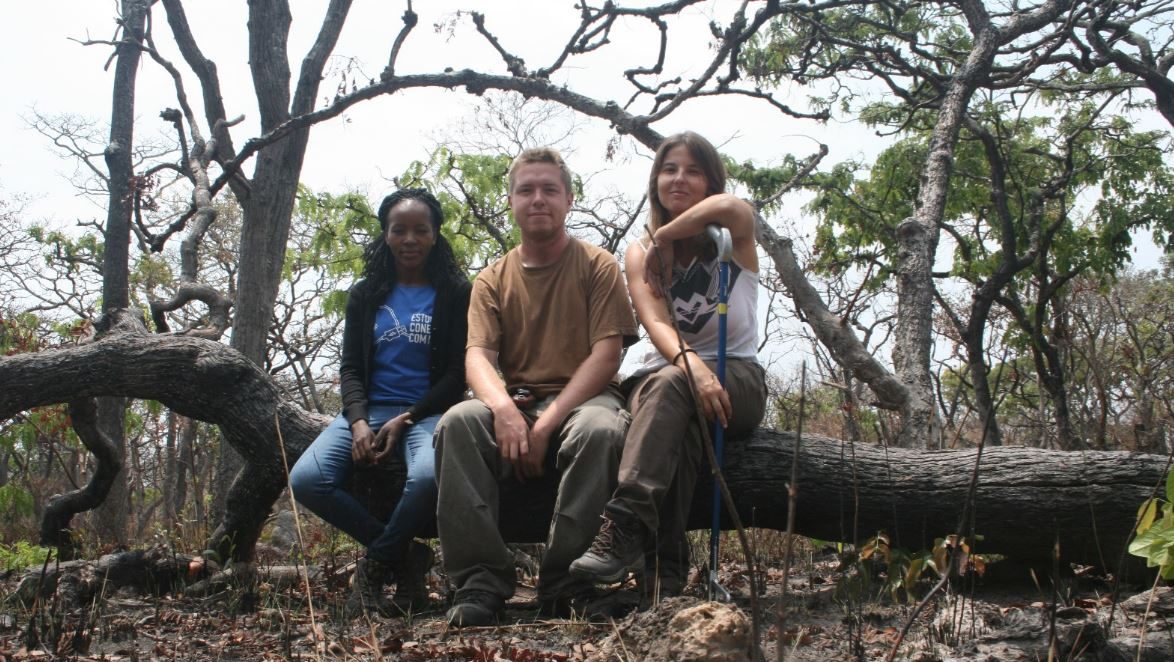It’s not every day that a young female scientist is honored alongside David Attenborough and E. O. Wilson. But that’s exactly what happened to TNC scientist Suzana Bandeira, who earlier this year was immortalized in Linnean binomial when a new Angolan skink species was named in her honor.
“It’s such an honor,” says Bandeira, speaking from her home in Angola’s capital, Luanda. “It feels like I’m conservation royalty.” Other species are named after French and Angolan herpetologists, an Angolan chieftain, and the Ovahelelo ethnolinguistic group.

As an undergraduate, Bandeira was studying biology, with a focus on marine biology, when her professor invited her to join a herpetological expedition with Portuguese and American scientists. One of those scientists was Luis Ceríaco, now a research associate at the Carnegie Museum of Natural History, and author of the study naming seven new Angolan reptiles.
“I was so excited to be in the field for three weeks, because all of my previous fieldwork was just around my university in Luanda,” she says. Bandeira had such a good time that she changed her thesis from marine biology to reptiles, and never looked back.
Bandeira went on to study reptile evolution and ecology at Villanova University. “They have a big project to review all the historical records [of reptiles in Angola] from colonial times and update them,” she says, “and in this process they’ve discovered about 20 new species, including amphibians.”
Suzana’s Wedge-Snouted Skink
It was during this research project that Ceríaco and his co-authors discovered and named a species after Bandeira: Trachylepis suzanae, the Suzana’s wedge-snouted skink (or the “lagartixa de Suzana Bandeira” in Portuguese). The species was first collected in 2016, when the research team was exploring Kissama National Park about 50 kilometers outside of Luanda. Scientists initially assumed it was another species in the Trachylepis genus. The specimen sat preserved in a jar of alcohol for eight years, before researchers sequenced its DNA from a liver sample and discovered that it was, in fact, a new species.

Suzana’s wedge-snouted skink is a medium-size skink with a wedge-shaped head and distinctive stripes running along each side of its body. It lives in the coastal area of north and central Angola, preferring mixed forest-savanna habitats with sandy soils. It’s often found near the beach and along riverbanks, where it digs burrows into the sand. It’s one of seven new species of reptiles described in a recent issue of the Bulletin of the American Museum of Natural History.
Bandeira was thrilled when Ceríaco called her and told her he named one of the new species after her, alongside conservationists David Attenborough and E.O. Wilson. It’s a well-deserved honor, especially as Bandeira is one of very few Angolan herpetologists. “We don’t have many people studying reptiles and amphibians in this country,” she explains. “And most herpetology is done by international scientists.”

Bandeira has always approached work with an eye to conservation. Prior to joining The Nature Conservancy, she worked for the Angolan government identifying hotspots of reptile biodiversity to inform the establishment of new protected areas.
“Angola is a hotspot for reptiles, she says, “It’s the third most diverse country after South Africa and Namibia.” Bandeira notes that civil war made Angola inaccessible for foreign researchers for the last several decades, and so the true number of reptiles is likely much higher than currently known.
She attributes that diversity to Angola’s diversity of biomes. Angola transitions from tropical forests all the way through to the arid Namib Desert, and that variety of habitats results in a fantastic array of reptiles. “We have so many endemics that just occur here and the Suzana skink is one of them.”

TNC Conservation Science in the Okavango
Bandeira now works as a monitoring, evaluation, and learning specialist, where she focuses on peatland conservation in the Okavango Basin. “Angola has the second largest extent of tropical peatlands in Africa after the Congo Basin, and those peatlands are still quite pristine, thanks to the history of the country and low population density,” explains Bandeira. What’s more, waters that fall in the Angolan highlands feed the lush boom and bust cycle downstream in the Okavango Delta, which supports more than 700 species of mammals, birds, fish, amphibians and reptiles.
TNC is trying to maintain these systems and avoid negative impacts from development. “Our work centers on community-based conservation through forestry protection, fisheries and peatlands,” explains Bandeira. “So we’re addressing protection and avoided impact and also working with local partners and communities to build capacity for long-term project sustainability.”
Even though she’s not working as a herpetologist, Bandeira still gets out on the weekends to go herping with her children. “Reptiles are everywhere, and my husband is always scared I’ll bring something scary home,” she laughs.

She says that foundational taxonomic work, like the research project that discovered the Suzana’s wedge-snouted skink, is absolutely critical for conservation. “It’s really easy to say that an area is just a beautiful landscape, but a key component of conservation is to have enough information about species distributions, occurrence, and endemism, along with ecosystem services.” That information allows researchers to assess a place’s value for connectivity, the geographic distribution of species, or ecological corridors.
“When you start talking about snakes and skinks, most people don’t care,” she adds. “They don’t feel a connection with reptiles because we don’t interact with them as easily, like mammals or birds. But all species play a role in the ecosystem.”
Including the wonderful little wedge-snouted skink that now bears Bandeira’s name.




With modern backlash against using any human names in Species naming, is this a good idea? We have such backlash in the Birding community against Audubon and so many others who became horrible people as we learned more about them as time passed and cultures change.
Well-done Suzana Bandeira! Congratulations on this honor!